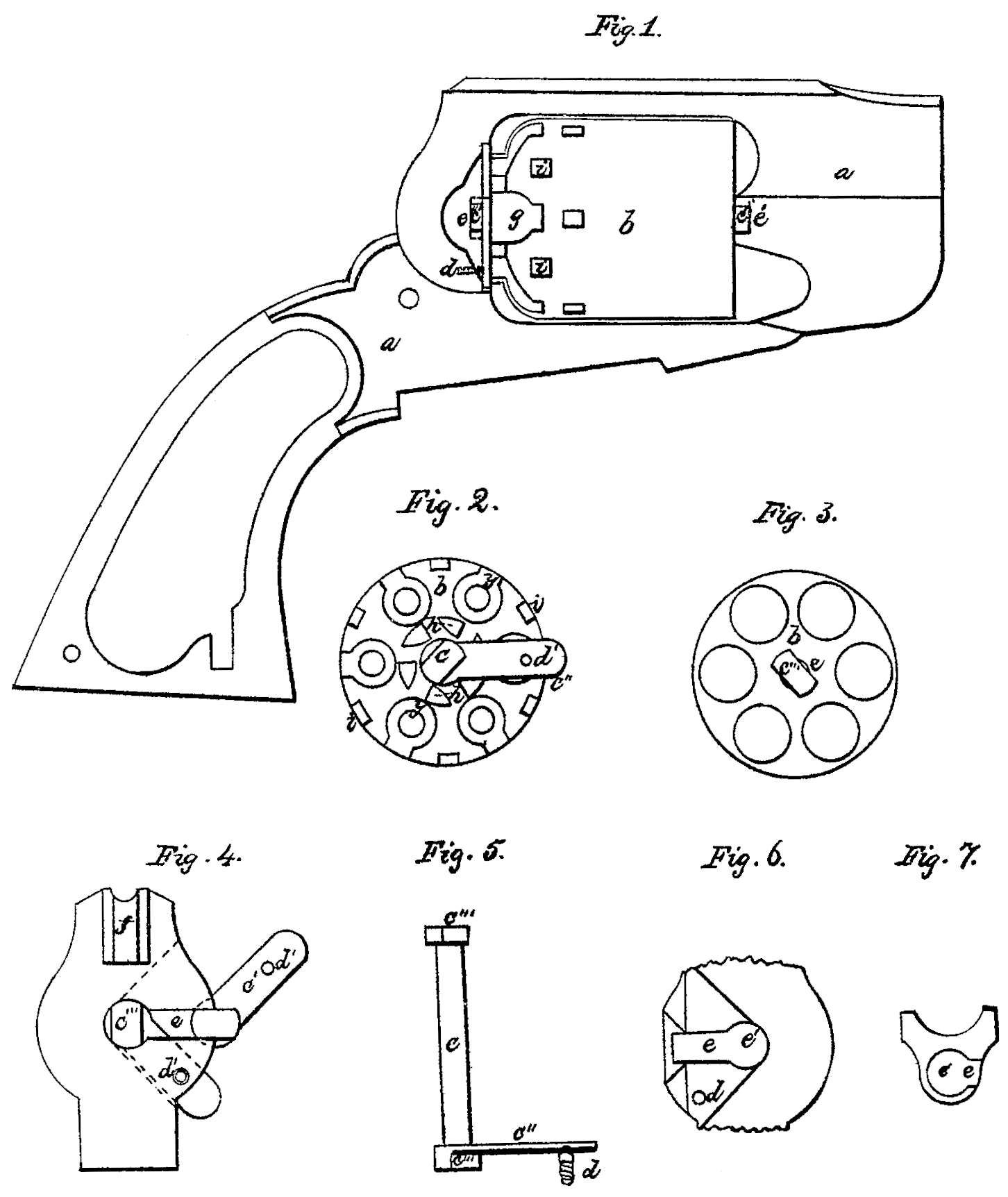US 47707
UNITED STATES PATENT OFFICE.
WM. H. ELLIOT OF PLATTSBURG, NEW YORK.
IMPROVEMENT IN CYLINDER-PINS OF REVOLVING FIRE-ARMS.
Specification forming part of Letters Patent No. 47,707, dated May 16, 1865.
To all whom it may concern:
Be it known that I, Wm. H. Elliot, of Plattsburg, in the county of Clinton, in the State of New York, have invented a new and Improved Base-Pin for Revolving Pistols; and I do hereby declare that the following is a full and exact description thereof, reference being had to the accompanying drawings, and to the letters of reference marked thereon.
Similar letters of reference indicate the same devices in all the figures.
To enable others skilled in the art to comprehend, make, and use my invention, I will proceed to describe its nature, construction, and operation.
The nature of my invention consists in so constructing and applying the base-pin of revolving pistols that the cylinder is locked in its place in the frame by turning the base-pin upon its axis, and also in providing a base-pin, when so constructed and applied, with a catch to prevent it, when adjusted, from turning upon its axis, so as to release the cylinder from the frame by accident.
Figure 1 is an elevation of the frame and cylinder of one of the Remington army pistols, showing the necessary alterations in the frame to adapt it to my new base-pin. Fig. 2 is an elevation of the rear end of the cylinder and base-pin. Fig. 3 is an elevation of the forward end of the cylinder and base-pin. Fig. 4 is a section of the frame in the rear of the cylinder at the end of the base-pin. Fig. 5 is an elevation of the base-pin. Fig. 6 is an elevation of that portion of the frame against which the rear end of the cylinder rests when in use. Fig. 7 is an elevation of that portion of the frame against which the forward end of the cylinder rests.
a is the frame; b, cylinder; c, base-pin; c’, position in which it enters the frame; c”, arm of the base-pin; c”’, heads of the base-pin; d, catch which prevents the base-pin from turning upon its axis; d’, depression into which the catch d falls; e, passages cut in the frame for the heads of the base-pin; e’, central bearing in the frame for the heads of the base-pin; f, hammer-cut; g, cone-seats; h, ratchet; i, notches between the cone-seats for the nose of the hammer to rest in.
My invention relates more particularly to that kind of revolving pistol which has a loading-lever under the barrel; and its principal object is to provide a good practical base-pin, so constructed as to allow the cylinder to be readily removed from the arm without first displacing the lever.
By reference to the drawings it may be seen that the central bearings, e’, in the frame are circular, and the heads of the base-pin c”’, which rest in the bearings, are first made circular, so as to fill the central bearings, but afterward flattened sufficiently to pass through the passages e. In adjusting the cylinder in the frame the base-pin is turned, so that its flattened heads will pass through the passages, as shown at c, Fig. 4. Then by passing the base-pin in laterally till its leads reach the central bearing, and by giving the base-pin a quarter-turn upon its axis, the broad sides of its heads are presented to the passages, as seen at c, Fig. 4, in which position the heads cannot pass out through them, but remain locked in the central bearing. As the base-pin is turned to lock the cylinder the arm c” passes over the catch d, which falls into a depression, d’, on the under side of the arm, and thus prevents the base-pin from being turned back by accident, so as to release the cylinder. A slight elasticity of the arm allows it to pass over the catch. When it becomes necessary to remove the cylinder from the frame the end of the arm is elevated by the end of the thumb of the right hand, which places the heads of the base-pin in the same relation to the passages that they were in when the cylinder was passed into the frame. In this position the heads of the base-pin readily ass out through the passages, thus releasing the cylinder from the frame.
In addition to the advantage of removing the cylinder and base-pin from the frame without disturbing the lever, my improvement has the further advantage of simplicity, both in construction and operation, as well as of cheapness and durability.
It is not necessary that the central bearings should be round or the heads of the base-pin flattened. Any shape that would allow the heads to pass through the passages into the central bearing and would not allow them to pass out after giving the base-pin a turn upon its axis would be substantially the same thing. The catch for preventing the base-pin from turning back by accident need not necessarily be upon the arm of the base-pin. Neither is it necessary that the catch should be attached to the frame and the depression into which it falls upon the base-pin. They may be reversed. The catch may be upon the base-pin and the depression upon the frame, and serve the same purpose.
What I claim as my invention, and desire to have secured to me by Letters Patent of the United States, is—
1. Locking the cylinder into the frame by turning the base-pin upon its axis, substantially as set forth.
2. Providing a base-pin which locks the cylinder by being turned upon its axis with a catch, d, to prevent it from being turned back by accident, substantially as described.
WM. H. ELLIOT.
Witnesses:
Thos. Richardson,
I. Quackenbush.

